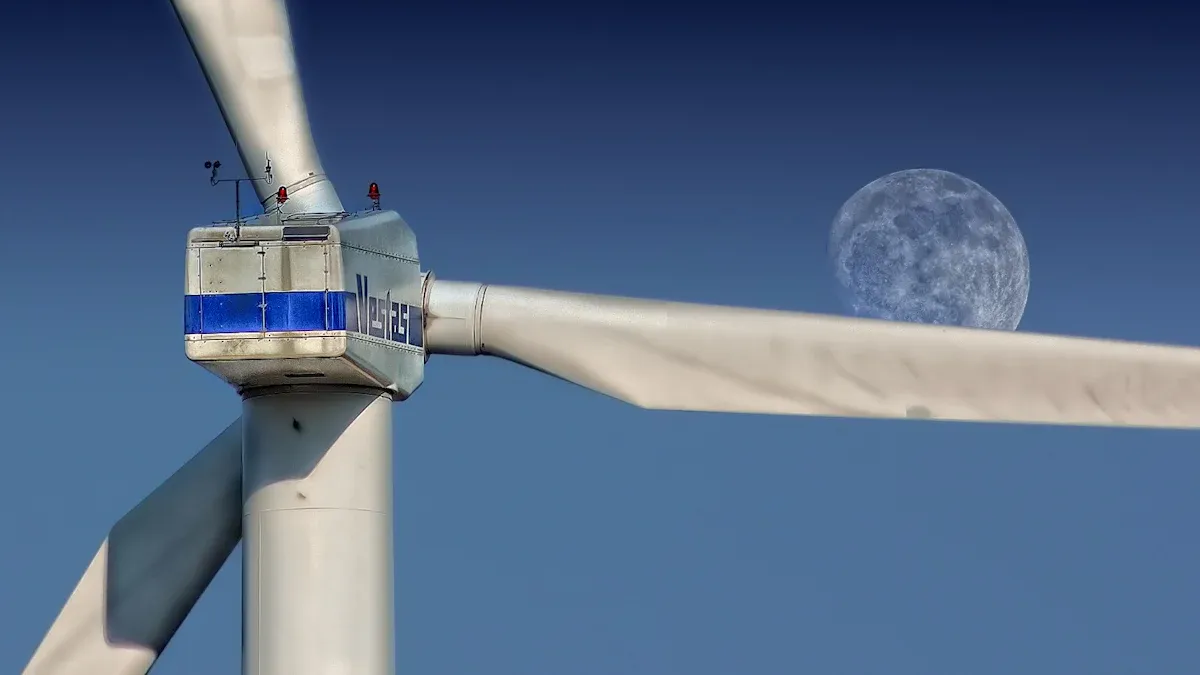
Forging plays a pivotal role in manufacturing the Forging Wind Turbine Shaft, delivering exceptional durability and reliability. This process transforms raw materials into high-strength components capable of withstanding extreme mechanical stress and environmental conditions. As wind turbine designs evolve to meet growing energy demands, precision-forged shafts have become indispensable for ensuring operational efficiency and longevity.
The wind turbine forging market continues to expand, driven by advancements in materials that offer superior strength-to-weight ratios. These innovations enable the production of lighter yet sturdier shafts, enhancing turbine performance across diverse applications. Rongli Forging exemplifies expertise in this field, producing forged wind turbine shafts that meet the rigorous demands of modern renewable energy systems.
Key Takeaways
- Forging makes wind turbine shafts stronger and tougher for heavy use.
- It improves the metal’s structure, helping it last longer and resist damage.
- Custom forging ensures shafts fit different wind turbine designs perfectly.
- Forged shafts save materials and lower costs, helping the environment.
- These parts work well in tough places, like offshore wind farms.
- Using advanced materials makes shafts lighter but still very strong.
- Forging cuts down on repairs and downtime, saving money and time.
- Rongli Forging creates strong shafts that meet global quality standards.
Understanding Forging Wind Turbine Shaft
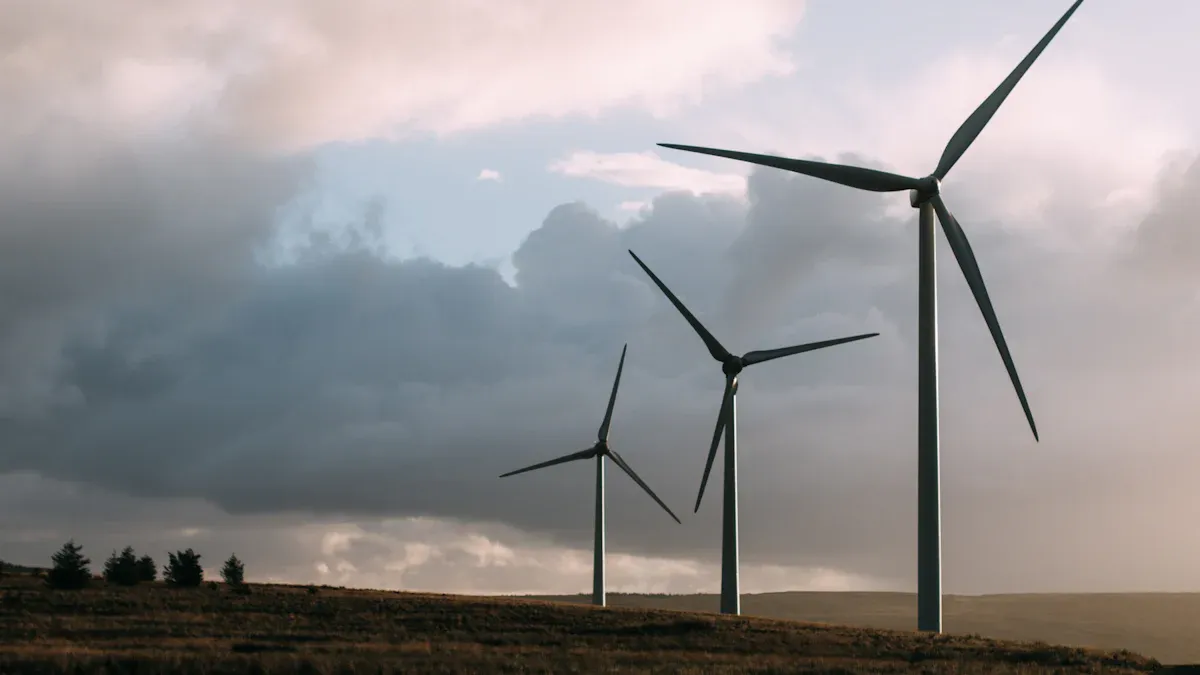
What Is Forging
Forging is a manufacturing process that shapes metal using localized compressive forces. This technique, often performed with a hammer or die, enhances the mechanical properties of the material, making it stronger and more durable. In the context of wind turbines, forging plays a critical role in producing components like the Forging Wind Turbine Shaft, which must endure high mechanical loads and harsh environmental conditions.
The process involves various methods, such as closed die forging, drop forging, and flashless forging, each tailored to specific applications. For instance, closed die forging shapes metal within a die cavity, ensuring minimal material waste and precise dimensions. These methods, combined with advanced materials like alloy steel, result in components with superior strength and resilience. The integration of directional properties further optimizes the shaft’s performance under load, making it ideal for both onshore and offshore wind turbines.
| Term | Definition |
|---|---|
| Forging | A metal shaping process involving localized compressive forces using a hammer or die. |
| Alloy steel forging | Made from steel containing additional alloying elements to enhance properties. |
| Closed die forging | A process where metal is shaped in a die cavity with minimal excess material. |
| Directional properties | Refers to the orientation of properties within a forging to optimize strength under load. |
Key Steps in the Forging Process
The forging process for wind turbine shafts involves several key steps, each contributing to the final product’s quality and performance. These steps include:
- Tool Design and Selection: Engineers design custom dies to achieve the desired shape and dimensions of the shaft.
- Billet Preparation: The raw material, or billet, is cut to size and heated to the required temperature. This step ensures the material becomes malleable for shaping.
- Forming: The heated billet undergoes shaping through methods like pressing between dies or cold forging, depending on the application.
- Finishing: Excess material, known as flashing, is trimmed, and the shaft undergoes additional processes to meet precise specifications.
| Step | Description |
|---|---|
| 1 | Tool design and selection, including custom die design for specific shapes. |
| 2 | Cutting the billet to size and heating it to the required temperature. |
| 3 | Forming the heated billet using various methods (e.g., pressing between dies, cold forging). |
| 4 | Finishing procedures, such as trimming any excess material (flashing). |
These steps ensure that the Forging Wind Turbine Shaft meets the stringent demands of modern wind energy systems, delivering exceptional strength and durability.
Benefits of Forging for Wind Turbine Shafts
Forging offers numerous advantages for manufacturing wind turbine shafts, making it the preferred method for this critical component. Some of the key benefits include:
- Enhanced Mechanical Properties: Forged shafts exhibit superior strength and toughness, enabling them to withstand high mechanical loads and extreme environmental conditions.
- Improved Grain Structure: The forging process refines the metal’s grain structure, enhancing its resistance to fatigue and wear. This results in longer-lasting components that require less maintenance.
- Customization and Precision: Advanced forging techniques allow for precise customization, ensuring the shaft fits the specific requirements of each wind turbine design.
- Sustainability: By utilizing high-grade materials and efficient processes, forging reduces material waste and supports the production of lighter, more durable shafts. These innovations improve turbine performance and contribute to a greener energy future.
Forged wind turbine shafts are essential for transmitting rotational energy from the rotor to the generator. As the demand for larger turbines like the Haliade-X grows, the need for longer and stronger shafts becomes increasingly critical. Forging meets these challenges by delivering components that combine strength, durability, and precision.
Note: The use of advanced materials and digital monitoring capabilities further enhances the performance and reliability of forged wind turbine shafts, ensuring they remain a cornerstone of renewable energy systems.
Why Forging Is Superior to Other Methods
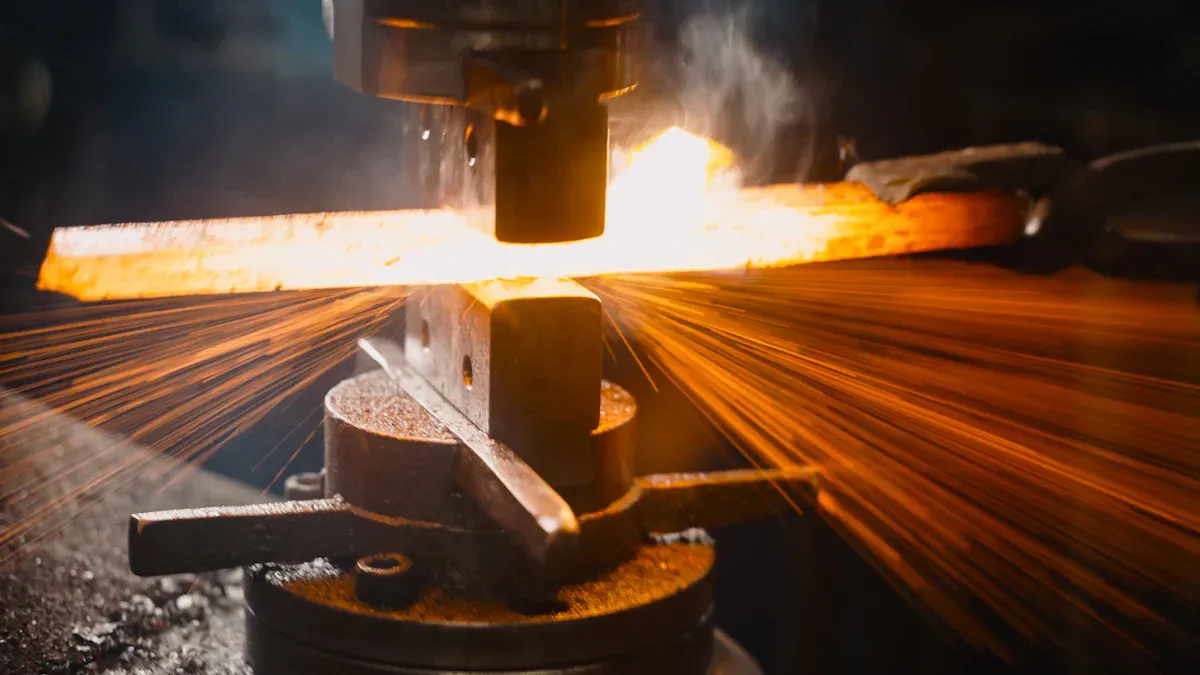
Forging vs. Casting
Forging and casting are two widely used manufacturing methods, but forging offers distinct advantages for critical components like wind turbine shafts. Casting involves pouring molten metal into a mold, allowing it to solidify into the desired shape. While this method is suitable for complex geometries, it often results in components with lower strength and durability. The cooling process in casting can create internal voids or porosity, which weakens the material and makes it less reliable under high mechanical loads.
In contrast, forging uses compressive forces to shape heated metal, resulting in a denser and more uniform structure. This process eliminates internal defects and enhances the mechanical properties of the material. For applications like wind turbines, where components must endure extreme stress and environmental conditions, forging provides unmatched reliability. The Forging Wind Turbine Shaft, for instance, benefits from the superior strength and toughness achieved through this method, ensuring long-term performance and reduced maintenance requirements.
Forging vs. Machining
Machining involves cutting or shaping metal using tools like lathes or mills. While this method allows for high precision, it often leads to material waste and higher production costs. Machined components may also lack the inherent strength of forged parts, as the process does not refine the metal’s grain structure. This limitation makes machining less suitable for demanding applications like wind turbines.
Forging, on the other hand, produces components with enhanced durability and cost efficiency. By shaping metal in a single step, forging minimizes material waste and reduces production time. Although the initial cost of forging dies can be high, the operational costs are significantly lower, especially for large production runs. Forged parts also exhibit superior strength and resilience, making them ideal for critical applications. These advantages make forging the preferred choice for manufacturing wind turbine shafts, where reliability and performance are paramount.
- Key Differences Between Forging and Machining:
- Forging produces stronger and more durable components.
- Machining generates more material waste and higher costs.
- Forging is better suited for large-scale production, offering long-term cost savings.
Advantages of Forging for Wind Turbine Shafts
Forging offers several advantages that make it the ideal method for manufacturing wind turbine shafts. These benefits include:
- Superior Strength and Durability: Forged components exhibit higher strength and toughness, enabling them to withstand extreme mechanical loads and environmental conditions.
- Cost Efficiency: The forging process reduces material waste and production time, resulting in lower operational costs. Automation further enhances cost efficiency for large production volumes.
- Enhanced Grain Structure: Forging refines the metal’s grain structure, improving resistance to fatigue and wear. This ensures longer-lasting components with minimal maintenance needs.
- Customization: Advanced forging techniques allow for precise customization, ensuring that each shaft meets the specific requirements of modern wind turbine designs.
These advantages highlight why forging remains the preferred method for producing critical components like the Forging Wind Turbine Shaft. By combining strength, durability, and cost efficiency, forging supports the development of reliable and sustainable wind energy systems.
Properties of Forged Wind Turbine Shafts
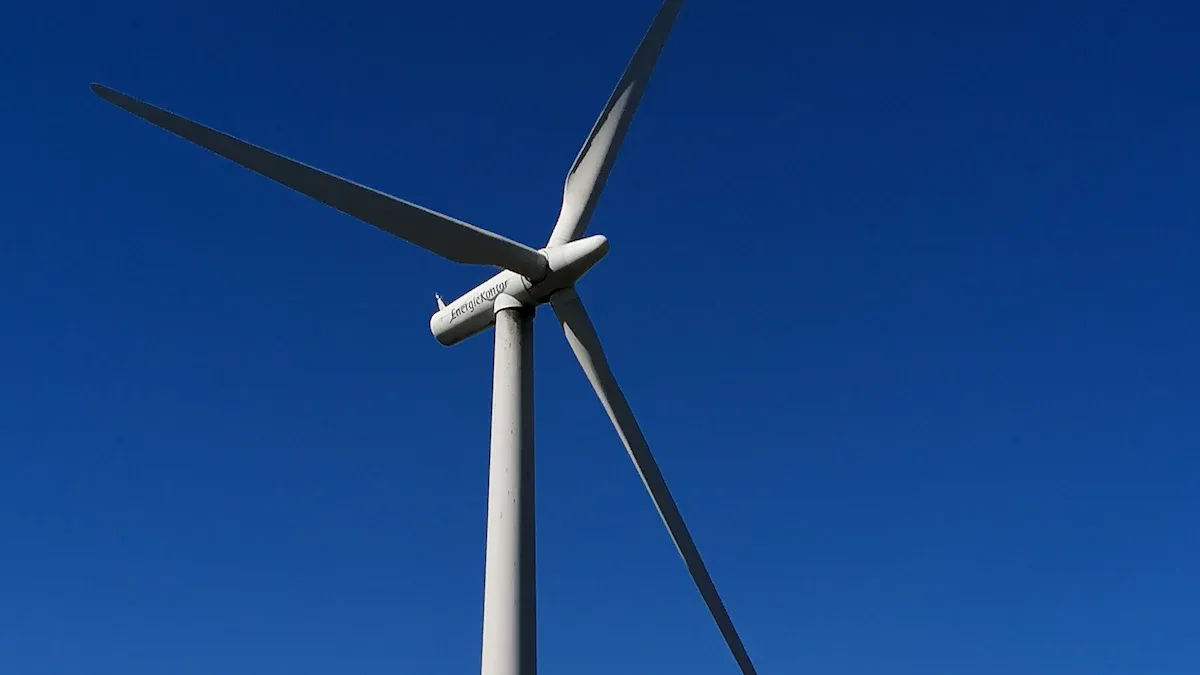
Enhanced Strength and Toughness
Forged wind turbine shafts exhibit exceptional strength and toughness, making them ideal for demanding applications in renewable energy systems. The forging process enhances the material’s tensile strength, enabling it to endure significant mechanical stress without failure. Studies from the University of Toledo reveal that forged components possess a 26% higher tensile strength compared to cast-iron parts. This increased strength ensures that the shafts can handle the immense forces generated during turbine operation.
Additionally, forged shafts demonstrate superior toughness, which allows them to absorb energy and resist fractures under sudden impacts. This property is particularly crucial for wind turbines operating in harsh environments, such as offshore locations, where unpredictable weather conditions can exert extreme forces on the components. By combining strength and toughness, forged wind turbine shafts deliver unmatched reliability and durability.
Resistance to Fatigue and Wear
Wind turbine shafts must endure continuous rotational motion and fluctuating loads, which can lead to fatigue and wear over time. Forging significantly enhances the shaft’s resistance to these challenges, ensuring a longer operational lifespan. The refined grain structure achieved through forging minimizes internal defects, reducing the likelihood of fatigue cracks forming under repeated stress.
Technical analyses highlight the superior fatigue strength of forged components, which contributes to their ability to withstand heavy-duty conditions. This resistance to fatigue ensures that the shafts maintain their structural integrity even after prolonged use. Furthermore, the forging process improves the material’s wear resistance, protecting the shafts from surface degradation caused by friction and environmental factors. These properties make forged wind turbine shafts a reliable choice for both onshore and offshore applications.
Superior Grain Structure for Longevity
The forging process refines the metal’s grain structure, aligning it in a way that enhances the shaft’s mechanical properties. This superior grain structure provides several benefits, including increased strength, improved toughness, and enhanced resistance to fatigue and wear. The directional alignment of the grains ensures that the shaft can efficiently handle mechanical loads, reducing the risk of failure.
Moreover, the refined grain structure contributes to the shaft’s longevity by minimizing internal voids and defects. This results in a more uniform and dense material, which enhances the overall performance and reliability of the component. The superior grain structure of forged wind turbine shafts ensures that they can withstand the demanding conditions of wind energy production, delivering consistent performance over their operational lifespan.
Tip: The advanced forging techniques used by Rongli Forging ensure that each Forging Wind Turbine Shaft meets the highest standards of quality and durability, making them a cornerstone of modern renewable energy systems.
How Forging Powers Wind Turbine Reliability
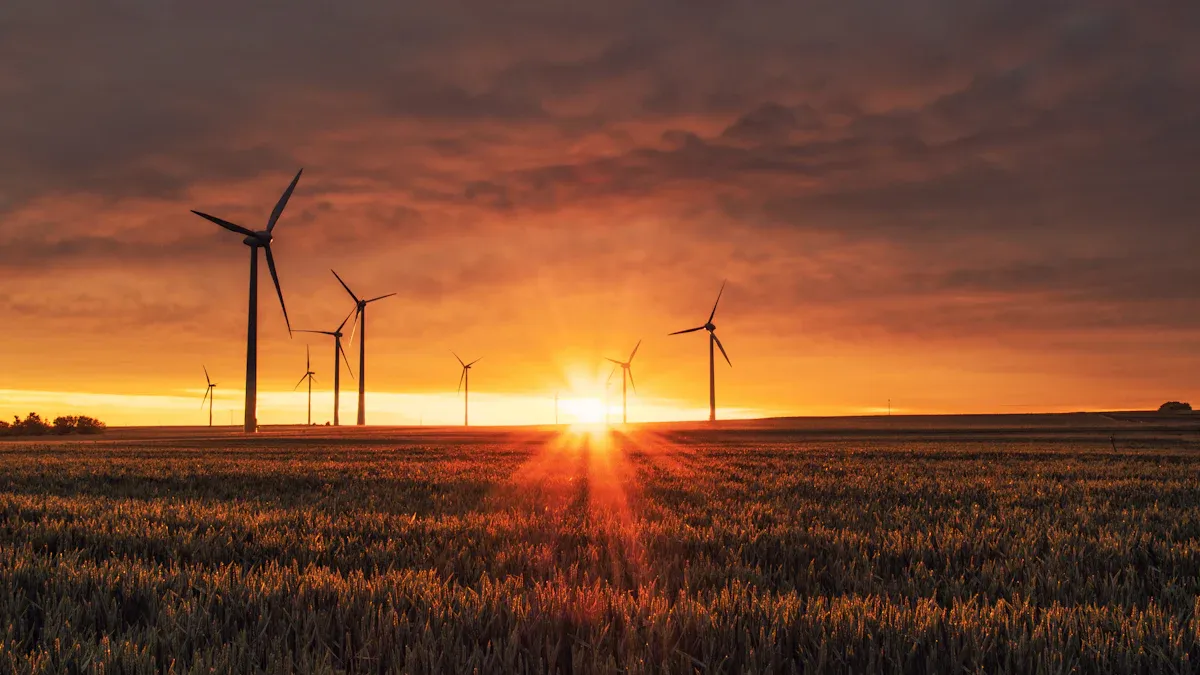
Withstanding Harsh Environmental Conditions
Forged wind turbine shafts excel in environments where extreme weather and corrosive elements challenge component durability. Offshore wind farms, such as those in the North Sea, demand components capable of enduring saltwater exposure, high humidity, and fluctuating temperatures. Forging enhances the material’s density and eliminates internal voids, creating a robust structure resistant to corrosion and environmental degradation. This makes forged shafts an ideal choice for turbines operating in harsh marine conditions.
Larger offshore turbines, like GE’s Haliade-X, rely on high-strength forged components to maintain reliability. These turbines face constant exposure to strong winds and turbulent seas, which exert immense stress on their structural elements. Forged shafts provide the resilience needed to withstand these forces, ensuring uninterrupted energy production. The growing adoption of forging in offshore projects underscores its critical role in enhancing turbine reliability under challenging conditions.
Supporting High Mechanical Loads
Wind turbines generate immense mechanical loads during operation, particularly in high-capacity models designed for large-scale energy production. Forged wind turbine shafts are engineered to handle these loads with exceptional strength and toughness. The forging process aligns the metal’s grain structure, optimizing its ability to distribute stress evenly. This reduces the risk of deformation or failure, even under prolonged and intense mechanical pressure.
The demand for durable components has driven the growth of the wind turbine forging market. As turbines increase in size and capacity, the need for stronger shafts becomes more pronounced. Forged shafts meet this demand by delivering superior performance in both low-speed and high-speed applications. Their ability to support heavy loads without compromising structural integrity makes them indispensable for modern wind energy systems.
Reducing Maintenance and Downtime
Maintenance and downtime are significant concerns for wind turbine operators, as they directly impact energy output and operational costs. Forged wind turbine shafts minimize these issues by offering enhanced resistance to fatigue and wear. The refined grain structure achieved through forging reduces the likelihood of cracks or surface degradation, extending the component’s lifespan.
By reducing the frequency of repairs and replacements, forged shafts contribute to lower maintenance costs and improved turbine efficiency. This reliability is particularly valuable in offshore wind farms, where maintenance operations are logistically complex and expensive. The use of forged components ensures that turbines remain operational for longer periods, maximizing energy production and return on investment.
Note: Rongli Forging’s expertise in producing high-quality forged wind turbine shafts highlights the importance of precision engineering in reducing maintenance needs and enhancing turbine reliability.
Real-World Success Stories of Forged Wind Turbine Shafts
Case Study: Offshore Wind Turbines
Offshore wind turbines operate in some of the most challenging environments, where durability and reliability are paramount. Forged shafts play a critical role in these installations by transmitting rotational energy from the rotor to the generator. The increasing size of turbines, such as GE’s Haliade-X, has amplified the need for longer and more robust components. These turbines, designed for high-capacity energy production, rely on forged shafts to endure the harsh marine conditions of saltwater exposure, high humidity, and fluctuating temperatures.
The European Union’s renewable energy targets have driven the expansion of offshore wind projects, further emphasizing the importance of reliable components. Forged shafts meet these demands by offering superior strength and resistance to environmental degradation. Their dense structure, free from internal voids, ensures consistent performance even under extreme stress. This reliability has made forged shafts indispensable in advancing offshore wind energy, supporting global efforts to reduce carbon emissions.
Case Study: High-Capacity Wind Farms
High-capacity wind farms require components that can handle immense mechanical loads and continuous operation. Forged wind turbine shafts excel in these demanding conditions, providing the strength and durability needed for large-scale energy production. Their refined grain structure enhances fatigue resistance, ensuring long-term reliability and reduced maintenance requirements.
In high-capacity installations, such as those in the United States and China, forged shafts have demonstrated exceptional performance. These components enable turbines to operate efficiently, even under fluctuating wind speeds and heavy loads. By minimizing downtime and maintenance costs, forged shafts contribute to the overall success and profitability of high-capacity wind farms. Their role in these projects highlights the critical importance of precision engineering in renewable energy systems.
Insights from Rongli Forging
Rongli Forging has established itself as a leader in producing high-quality forged components for wind turbines. The company’s expertise in forging processes ensures that each shaft meets stringent international standards. Forged parts from Rongli exhibit 26% higher tensile strength compared to cast-iron components, making them ideal for demanding applications.
The benefits of forging extend beyond strength. Rongli’s forged components offer superior fatigue resistance, uniform composition, and cost-effectiveness. These advantages make them suitable for various industries, including renewable energy, marine, and construction. By preventing defects like porosity, Rongli reduces material waste and production costs, ensuring efficient and sustainable manufacturing practices.
Note: Rongli Forging’s commitment to quality and innovation underscores the importance of forging in advancing renewable energy. Their expertise in producing the Forging Wind Turbine Shaft exemplifies the unmatched reliability and performance of forged components in modern wind energy systems.
The Future of Forging in Renewable Energy
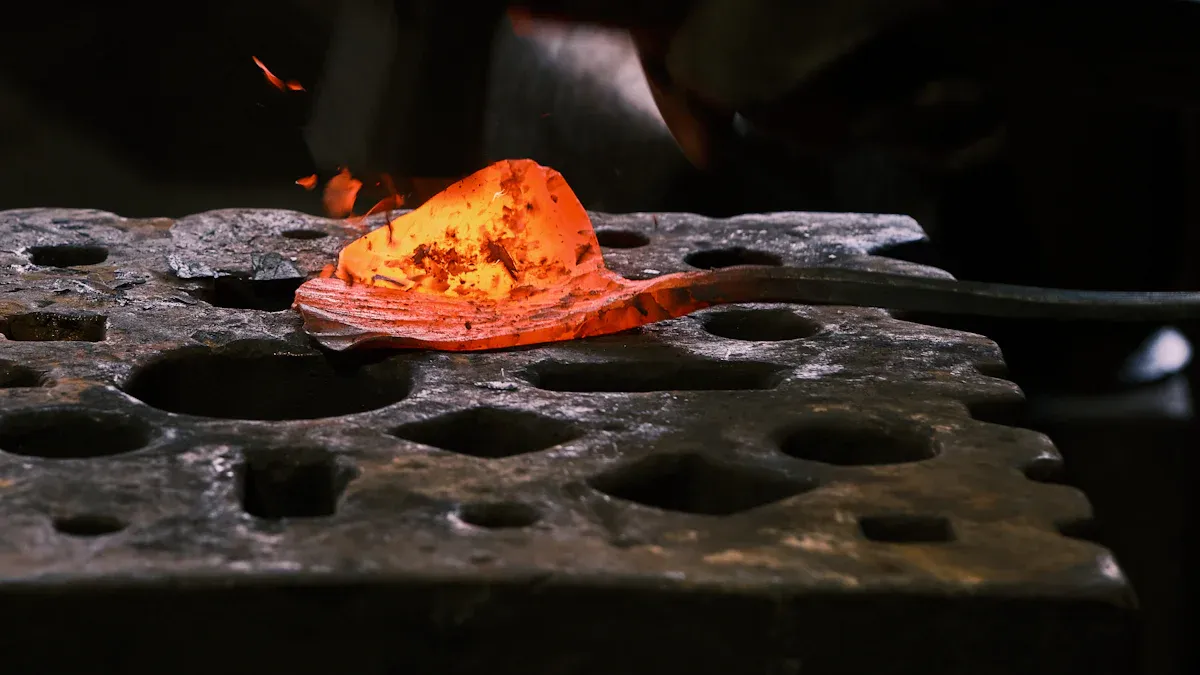
Innovations in Forging Technology
The forging industry continues to evolve with advancements in technology, driving efficiency and precision in manufacturing processes. Modern forging techniques now integrate automation and robotics, enabling manufacturers to produce components with unparalleled accuracy. These innovations reduce human error and enhance consistency, ensuring that each product meets stringent quality standards.
Digital monitoring systems have also revolutionized the forging process. Sensors embedded in forging equipment provide real-time data on temperature, pressure, and material flow. This information allows engineers to make immediate adjustments, optimizing the process for better performance. Additionally, 3D modeling and simulation tools enable manufacturers to design and test components virtually before production begins. These tools minimize material waste and shorten development cycles, making forging more sustainable and cost-effective.
Rongli Forging exemplifies the adoption of cutting-edge technology in the production of components like the Forging Wind Turbine Shaft. By leveraging these advancements, the company ensures that its products meet the demands of modern renewable energy systems.
Meeting the Growing Demand for Wind Energy
The global shift toward renewable energy has significantly increased the demand for wind turbines. As countries strive to meet ambitious climate goals, the need for reliable and durable components has never been greater. Forged wind turbine shafts play a crucial role in this transition, providing the strength and resilience required for large-scale energy production.
The rise of offshore wind farms and high-capacity turbines has further amplified this demand. These installations require components capable of withstanding extreme environmental conditions and mechanical stress. Forging meets these challenges by delivering parts with superior mechanical properties and long operational lifespans. Manufacturers like Rongli Forging are well-positioned to support this growth, offering customized solutions tailored to the unique requirements of each project.
By investing in advanced forging techniques and high-quality materials, the industry ensures that wind energy systems remain efficient and reliable. This commitment to excellence supports the global push for sustainable energy solutions.
Sustainability Benefits of Forged Components
Forging contributes to sustainability in several ways, making it an ideal choice for renewable energy applications. The process minimizes material waste by shaping metal with precision, reducing the need for additional machining. This efficiency not only conserves resources but also lowers production costs, making renewable energy more accessible.
Forged components also exhibit longer lifespans compared to those produced through other methods. Their enhanced durability reduces the frequency of replacements, decreasing the environmental impact associated with manufacturing and transportation. Furthermore, the use of high-grade, recyclable materials in forging aligns with the principles of a circular economy.
Rongli Forging demonstrates a strong commitment to sustainability by adhering to environmentally friendly practices. The company’s focus on quality and innovation ensures that its products contribute to a greener future. As the renewable energy sector continues to grow, forging will remain a cornerstone of sustainable manufacturing.
Forging remains a cornerstone in the production of durable and reliable wind turbine shafts. Its ability to enhance mechanical properties ensures these components withstand the rigorous demands of renewable energy systems. The growing wind turbine forging market reflects the increasing need for high-strength components, driven by advancements in turbine design and global renewable energy targets.
Rongli Forging exemplifies excellence in this field, delivering precision-engineered solutions that meet international standards. Their expertise in producing the Forging Wind Turbine Shaft highlights the unmatched reliability of forged components. As the renewable energy sector expands, forging will continue to play a pivotal role in supporting sustainable energy solutions.
Insight: The push for reduced carbon emissions and the rise of offshore wind projects underscore the critical importance of forging in modern energy systems.
| Evidence Type | Description |
|---|---|
| Market Growth | The wind turbine forging market is growing due to increased demand for high-strength components driven by renewable energy targets. |
| Technological Advancements | Larger and more efficient turbine designs necessitate specialized forged components for enhanced reliability. |
| Environmental Impact | The push for reduced carbon emissions is leading to more wind energy projects, increasing the need for durable forged components. |
FAQ
What makes forging superior for wind turbine shafts?
Forging enhances the mechanical properties of wind turbine shafts, providing superior strength, toughness, and resistance to fatigue. This process eliminates internal defects, ensuring components can withstand extreme mechanical loads and environmental conditions. These qualities make forging the preferred method for manufacturing reliable turbine components.
How does Rongli Forging ensure product quality?
Rongli Forging adheres to an ISO 9001:2008 Quality System, audited annually. The company employs advanced forging techniques, high-grade materials, and rigorous quality control measures. Experienced engineers oversee every step of production, ensuring each forged wind turbine shaft meets international standards for durability and performance.
What types of forged wind turbine shafts does Rongli offer?
Rongli Forging produces various types of forged shafts, including wind power generator shafts, main shafts, and low-speed shafts. Each type is tailored to specific operational needs, ensuring optimal performance in diverse wind turbine designs and environments.
Why are forged wind turbine shafts ideal for offshore applications?
Forged shafts resist corrosion, fatigue, and wear, making them ideal for offshore turbines exposed to saltwater, high humidity, and fluctuating temperatures. Their dense structure and refined grain alignment ensure durability and reliability in harsh marine conditions, supporting uninterrupted energy production.
How does forging contribute to sustainability?
Forging minimizes material waste by shaping metal with precision. The process also extends component lifespans, reducing the need for replacements. By using recyclable materials and efficient manufacturing practices, forging aligns with sustainability goals, supporting the renewable energy sector’s commitment to a greener future.
What role does grain structure play in forged shafts?
The forging process refines the metal’s grain structure, aligning it to enhance strength, toughness, and fatigue resistance. This superior grain structure ensures the shaft can handle mechanical loads efficiently, reducing the risk of failure and extending its operational lifespan.
How does Rongli Forging support custom requirements?
Rongli Forging offers precise customization for wind turbine shafts, tailoring each product to meet specific design and operational needs. Advanced forging techniques and expert engineering enable the company to deliver components that align perfectly with modern turbine specifications.
What industries benefit from Rongli Forging’s expertise?
In addition to renewable energy, Rongli Forging serves industries like marine, construction, and heavy machinery. The company’s forged components provide unmatched strength, durability, and cost efficiency, making them suitable for demanding applications across various sectors.
Tip: Contact Rongli Forging’s expert team for guidance on selecting the right forged wind turbine shaft for your project.
Post time: Mar-17-2025



